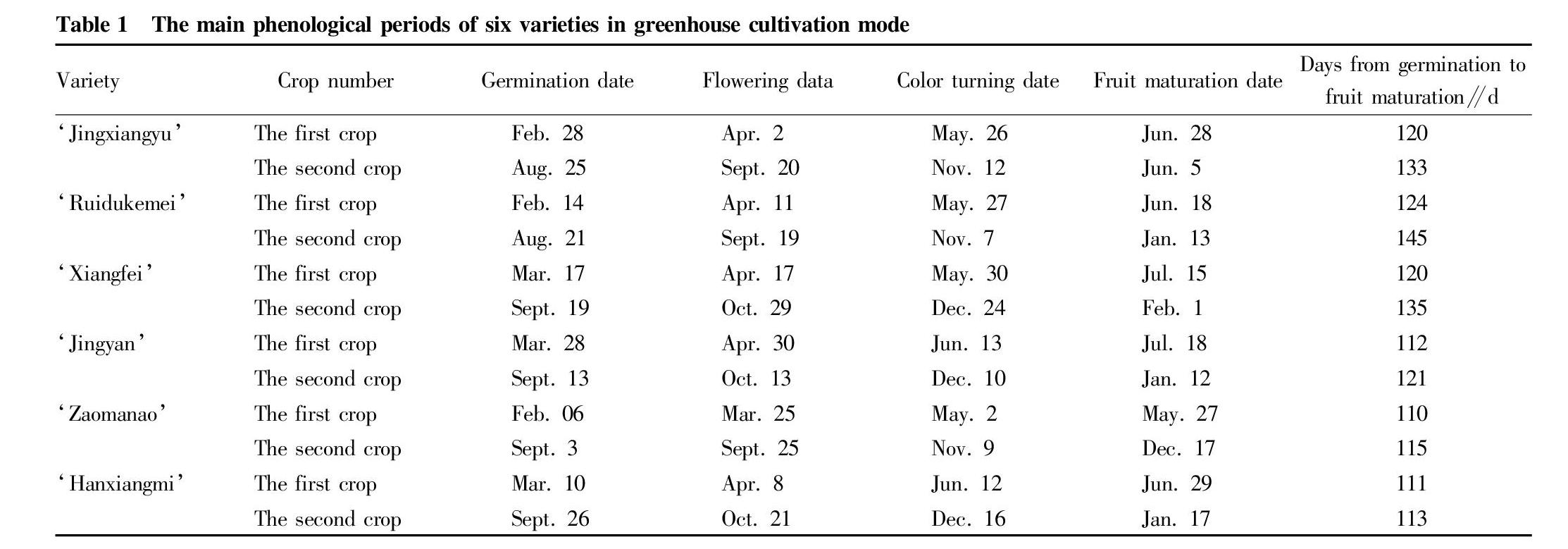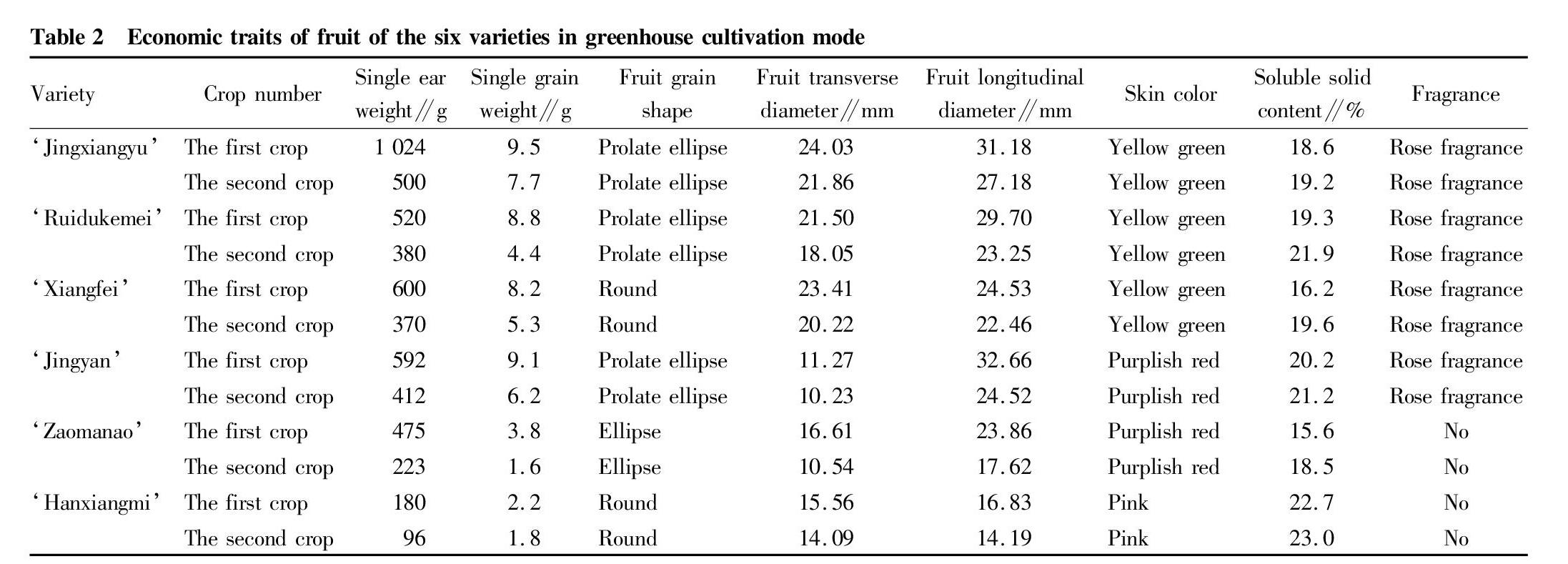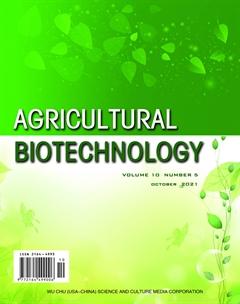Selection of Grape Varieties Suitable for Double Cropping a Year in Northern Greenhouse
Feng LI Jun JIA Xiaoyan SONG Xin LIU Xiaohua ZHU Qiang WANG



Abstract With the development of the greenhouse grape cultivation area, the supporting greenhouse grape varieties appear to be single. At present, there are few researches on the selection of grape varieties suitable for two-harvest-a-year cultivation in greenhouses. In order to meet the needs of fruit growers for the diversity of greenhouse grape varieties, experimental studies had been carried out. Through three consecutive years of two-harvest-a-year production of six grape varieties of ‘Jingxiangyu, ‘Ruidukemei, ‘Xiangfei, ‘Jingyan, ‘Zaomanao and ‘Hanxiangmi, the first crop of greenhouse grapes matured from May to July, and the second crop matured during the New Year餾 Day and Spring Festival. Through the investigation and analysis of their phenological periods, fruit economic characteristics and economic benefits, it was found that the four varieties of ‘Jingxiangyu, ‘Ruidukemei, ‘Xiangfei and ‘Jingyan performed well under greenhouse cultivation conditions, and thus can be used as supporting fine varieties for large-scale promotion.
Key words Grape; Greenhouse; Double cropping a year; Variety selection
Received: June 21, 2021 Accepted: August 26, 2021
Supported by Excellent Talent Training Fund in Yanqing District, Beijing; Jinqiao Seed Project in Yanqing District, Beijing; Ordos Science and Technology Program.
Feng LI (1986-), male, P. R. China, senior engineer, devoted to research about facility grape cultivation.
*Corresponding author.
Protected cultivation of grapes in China began in the 1950s, and large-scale production and cultivation began in the late 1980s and early 1990s, and was mainly distributed in northern China, such as Beijing, Liaoning, Qinghai, Ningxia, Hebei, Shandong and other places. At the end of 2015, the area of facility grapes in China had reached more than 187 000 hm2[1]. Greenhouse viticulture is a kind of table grape cultivation mode with high economic benefits. Its production not only accelerates the process of horticultural plant industrialization and agricultural production modernization, but also meets people餾 demand for fruits in different seasons.
As consumers demand for grape varieties continues to increase, some varieties with lower sugar content, small grains, and light flavor can no longer meet the needs of the market. Moreover, in the northern region, there are few famous, special, high-quality and new rare varieties, and the improper combination of early, mid- and late-maturing varieties and unobvious characteristics have caused too much concentration of grapes on the market, restricting the improvement of the efficiency of viticulture. Greenhouse grape cultivation with the characteristic of "double cropping a year" realizes two-season grape production based on the full use of local temperature and light resources, by promoting the differentiation of grape secondary flower buds, breaking the dormancy of winter buds in summer, combined with pruning, temperature control and other techniques[2]. The realization of double cropping a year for greenhouse grape can not only increase the yield of grapes, but also make up for the lack of one-time fruit and extend the fresh fruit sales period, playing a positive role in regulating grape market supply and extending the industrial chain. At present, there are few researches on the selection and cultivation techniques of grape varieties suitable for the two-harvest-a-year cultivation in greenhouses. In order to enrich the variety of grape varieties in the market, meet the diverse needs of consumers, solve the problem of grape supply in the off-peak and peak seasons, ensure annual supply, and promote fruit farmers to increase their incomes and become rich, an investigation was carried out on the phenological periods, fruit economic characteristics and economic benefits of six grape varieties of ‘Jingxiangyu, ‘Ruidukemei, ‘Xiangfei, ‘Jingyan, ‘Zaomanao and ‘Hanxiangmi from 2016 to 2018, and it was found that four varieties of ‘Jingxiangyu, ‘Ruidukemei, ‘Xiangfei and ‘Jingyan performed well under greenhouse cultivation conditions. They are suitable for two-harvest-a-year cultivation under northern greenhouse conditions, and have high promotion value. The summary report was as below.
Materials and Methods
General situation of the experimental fields
The experiment was carried out in the grape research and development center park of Yanqing District, Beijing. Yanqing District is located in the northwest of Beijing, with an average altitude of 500 m or more, an average annual temperature of 9.2 ℃, an average annual precipitation of 498.2 mm, and an annual active accumulated temperature of ≥10 ℃ of 3 832.5 ℃. The annual sunshine hours are 2 713.6 h, and the frost-free period is 206 d[3]. The framework of the solar greenhouse was a steel framework, with a ridge height of 3.5 m, a length of 60 m from east to west, and a width of 7 m from north to south. The rear wall was built with bricks, and filled with insulation materials in the middle, with a height of 2.2 m.
The tested grape varieties were ‘Jingxiangyu, ‘Ruidukemei, ‘Xiangfei, ‘Jingyan, ‘Zaomanao and ‘Hanxiangmi. The annual grafted seedlings were planted in the spring of 2010, and the rootstock was Beida. The planting type was a single-row type with plant spacing of 1.5 m. The cultivation frame was a shed frame, and the tree shape was a single-stem double-armed horizontal shape. The first crop of fruit matured from May to July, and the second crop of fruit matured during the New Year餾 Day and Spring Festival.
Index determination
After the fruit matured, 10 ears were randomly picked from each variety, and 10 fruit grains were randomly picked from each ear. A balance was used to measure the weights of single ear and single grain. A vernier caliper was used to measure the horizontal and vertical diameters of the fruit, and a TD-45 digital refractometer was used to determine the content of soluble solids. The measurement of each index was repeated 3 times, and the average value was taken. The yields of five trees were investigated for each variety, and the average yield was calculated and then converted to yield of per hectare.
Results and Analysis
Phenological period
It can be seen from Table 1 that there were big differences in the number of days from germination to fruit ripening between the six grape varieties under greenhouse cultivation conditions, especially the number of days from germination to fruit ripening between the first crop and the second crop. Specifically, the number of days from germination to fruit ripening was 120 d in the first crop of ‘Jingxiangyu, and was 133 d in the second crop, and the difference between the two was 13 d; the number of days from germination to fruit ripening was 124 d in the first crop of ‘Ruidukemei, and was 145 d in the second crop, and the difference between the two was 21 d; and the differences between the first crop and the second crop of ‘Xiangfei, ‘Jingyan, ‘Zaomanao and ‘Hanxiangmi were 15, 9, 5 and 2 d, respectively.
Grape varieties with less than 120 d of growth from germination to full maturity are extremely early-maturing varieties. Grape varieties with growth days ranging from 120 to 130 d from germination to full maturity are early-maturing varieties. And those with growth days between 130 and 150 d belong to the mid-maturing variety[4]. Judging from this, the first crops of ‘Jingxiangyu, ‘Ruidukemei and ‘Xiangfei all showed the characteristics of early maturity under the greenhouse cultivation conditions, and the second crops showed the characteristics of middle maturity; the first crops of ‘Jingyan showed extremely early maturity under the greenhouse conditions, and the second crops showed the characteristics of early maturity; and the first crops and the second crops of ‘Zaomanao and ‘Hanxiangmi all showed the characteristics of extremely early maturity under greenhouse cultivation conditions. The reason for these differences might be related to the temperature and humidity changes in the greenhouse before and after budding of the grape varieties.
Fruit economic traits
It can be seen from Table 2 that the first crops of ‘Jingxiangyu, ‘Ruidukemei, ‘Xiangfei and ‘Jingyan had a single ear weight of more than 500 g. Among them, the single ear weight of ‘Jingxiangyu was the largest, reaching 1 024 g, and the single ear weight of ‘Hanxiangmi was the smallest, only 180 g. In the second crops, except for the single ear weight of ‘Jingxiangyu which reached 500 g, the single ear weights of other varieties were all below 500 g. In terms of single-grain weight, the single-grain weights of ‘Jingxiangyu, ‘Ruidukemei, ‘Xiangfei, and ‘Jingyan were all above 8 g, showing the characteristics of large-grain varieties. Among them, the single-grain weight of ‘Jingxiangyu was the largest at 9.5 g, and the grains of ‘Zaomanao and ‘Hanxiangmi were smaller, with single-grain weights of 3.8 and 2.2 g, respectively. In terms of soluble solid content, the soluble solid content of ‘Jingxiangyu, ‘Ruidukemei, ‘Jingyan and ‘Hanxiangmi were all above 18%. The soluble solid content of ‘Hanxiangmi was the highest, reaching 22.7% and 23.0% in the first crop and the second crop, respectively, while the soluble solid contents of ‘Xiangfei and ‘Zaomanao were lower. The contents of soluble solids in the second crops of these 6 varieties were higher than that in the first crops, which might be due to the large difference in temperature between day and night in the greenhouse of the second crops, which was more conducive to the accumulation of grape sugar. In addition, the aroma substance metabolism is affected by the growing season at both the product level and the transcription level. In winter, grapes are richer in aroma substances and the fruit quality is better[5]. In terms of fruit fragrance, the four varieties of ‘Jingxiangyu, ‘Ruidukemei, ‘Xiangfei and ‘Jingyan all had a rose fragrance, and the taste was relatively crisp; and the two varieties of ‘Zaomanao and ‘Hanxiangmi had no fragrance, and the fruit was ripe and the flesh was softer.
Yield and economic benefits
From Table 3, it can be seen that the first crops per hectare of ‘Jingxiangyu, ‘Ruidukemei and ‘Xiangfei, had a yield of more than 15 000 kg. Among them, the yield per hectare of ‘Jingxiangyu was the highest, which was above 22 500 kg, followed by ‘Ridukemei and ‘Xiangfei, with a yield of 15 180-16 965 kg, and the yields per hectare of ‘Zaomanao and ‘Hanxiangmi were lower, at 7 770-10 305 kg. In greenhouse grape production of the second crops, the yields per hectare of the four varieties of ‘Jingxiangyu, ‘Ruidukemei, ‘Xiangfei and ‘Jingyan among these 6 varieties were all over 6 000 kg, and ‘Jingxiangyu showed the highest value, followed by ‘Ridukemei. According to the average yield performance of hectare of these 6 varieties a year, the yields from high to low were ‘Jingxiangyu, ‘Ruidukemei, ‘Xiangfei, ‘Jingyan, ‘Zaomanao and ‘Hanxiangmi. According to the economic performance of the fruit, the four varieties of ‘Jingxiangyu, ‘Ruidukemei, ‘Xiangfei and ‘Jingyan were more popular with consumers because of their fruity fragrance, and the picking prices were all over 50 yuan/kg. The two varieties of ‘Zaomanao and ‘Hanxiangmi had no fragrance and were less popular with consumers, so the picking prices were lower. Combining the yield and picking prices of these 6 grape varieties, the average annual output values in descending order were ‘Jingxiangyu, ‘Ruidukemei, ‘Xiangfei, ‘Jingyan, ‘Zaomanao and ‘Hanxiangmi.
Conclusions
The selection of varieties for two-harvest-a-year greenhouse cultivation mainly considers the flower bud differentiation ability of grape varieties under greenhouse cultivation conditions. The ability of grapes to form flowers is affected by the characteristics of varieties and environmental factors such as light and chilling requirements. Therefore, varieties suitable for double-cropping cultivation in a year must be tolerant to low light, require strong adaptability to the greenhouse cultivation environment and a low amount of cold, and have a strong ability to produce high yields year after year.
Through three consecutive years of investigation and analysis of the phenological periods, fruit economic characteristics and economic benefits of the 6 varieties of ‘Jingxiangyu, ‘Ruidukemei, ‘Xiangfei, ‘Jingyan, ‘Zaomanao and ‘Hanxiangmi, it was found that the four varieties of ‘Jingxiangyu, ‘Ruidukemei, ‘Xiangfei and ‘Jingyan performed well under greenhouse cultivation conditions, and the phenological periods of the two crops of these 4 varieties basically tended to be between mid-maturing and early-maturing under greenhouse cultivation conditions, which meets the requirements for grape varieties by two-harvest-a-year cultivation technology. Secondly, these four varieties performed well in the economic traits of the fruits under the greenhouse cultivation conditions. They all had large ears and large grains, and the fruit had a rose fragrance and high sugar content. In terms of yield and economic benefits, these four varieties had strong ability to continuously form flowers under greenhouse cultivation conditions, were relatively high-yielding, and had high economic value for picking. They are well recognized by the market and have high market potential. In summary, the four varieties of ‘Jingxiangyu, ‘Ruidukemei, ‘Xiangfei and ‘Jingyan were cultivated for two crops a year under greenhouse conditions, showing good economic characteristics of fruit, and they have great potential for market development and can be used as supporting fine varieties for large-scale promotion.
References
[1] LIU FZ. Current status and development trend of viticulture in China[J]. Deciduous Fruits, 2017, 49(1): 1-4. (in Chinese)
[2] WANG L. Research on key techniques of secondary fruit cultivation of grape in Zhejiang[J]. Hangzhou: Zhejiang University, 2016. (in Chinese)
[3] LI F, GAO L, WANG Q, et al. The early cultivation performance of six early-maturing grape varieties in Beijing[J]. Sino-Overseas Grapevine & Wine, 2015(2): 58-63. (in Chinese)
[4] KONG QS. Chinese grape history[M]. Beijing: China Agricultural Science and Technology Press, 2004: 135. (in Chinese)
[5] CHEN WK. Study on targeted metabolome and transcriptome of grape fruit under two-harvest-a-year cultivation model[M]. Beijing: China Agricultural University, 2018. (in Chinese)
[6] ZHAO JQ. Study on the flower bud differentiation of greenhouse grape and its influencing factors[M]. Beijing: Graduate School of Chinese Academy of Agricultural Sciences, 2014. (in Chinese)
[7] XIE JM. Evaluation and selection of suitable varieties for early cultivation of protected grapes[M]. Beijing: Graduate School of Chinese Academy of Agricultural Sciences, 2012. (in Chinese)
[8] ZHANG FC, ZHANG XH, PAN MQ, et al. Correlation between the photosynthetic characteristics and growth performance of grapes during forcing culture[J]. Xinjiang Agricultural Sciences, 2014(7): 1219-1226. (in Chinese)
- 农业生物技术(英文版)的其它文章
- Effects of Pruning Methods on the Growth and Development of New Shoots and Fruit Yield and Quality of Walnut
- Effects of Uniconazole on Photosynthetic Characteristics of Dahlia pinnata Cav. under Drought Stress
- Community Structure and Value Evaluation of Local Brassicaceae Potherbs in Shiyan City
- Home Planting Techniques of Green and Healthy Rape Sprouts
- Research Progress of Polygonatum Germplasm Resources in China
- Breeding and Application of Guidan 903, a New High-yield and Good-quality Maize Variety

